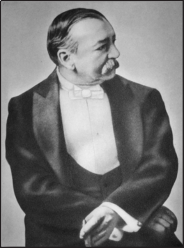- MALLOCK
- UNITED KINGDOM (see also List of Individuals)\
 12.3.1851 Cheriton Bishop/UK - 26.6.1933 Exeter/UK\Henry Reginald Arnulph Mallock's mother was the sister of William Froude (1810-1879), the famous naval engineer from Torquay. After leaving Oxford University, Mallock assisted his uncle Froude in working out the beautiful gear of the original ship model tank. In 1876, Mallock went on as assistant to Lord Rayleigh (1842-1919) and there was an accomplished mechanic with finest instrumentation construction. Mallock was fortunate in having lived among a group of brilliant men in the engineering world, including also Brunel and Benjamin Baker (1840-1907), and with his great mechanical skill and considerable mathematical ability and ingenuity was ready to attack and solve problems as they arose. He therefore was a consultant for the War Office, the Admiralty and the Air Force. It is unfortunate that much of his work was confidential but his interests were so wide that he found time to experiment and write papers upon a variety of topics, besides those of purely mechanical and engineering interests. Mallock did not seek publicity, quite the reverse: He cared nothing about the general public. He was of the old school of cleancut, exact mechanics and physics and he took no interest in what appeared to him the modern more nebular methods. He would not be photographed in the ordinary way and his portrait resulted only from a dinner party.\Mallock presented the 1912 James Forrest Lecture of the Institution of Civil Engineers on aerial flight. After a short historical account beginning with the first experiments of the brothers Montgolfier in 1788, he noted that the aeronautical propulsion until about 1890 was inadequate, resulting in small advance for a century. He investigated then the resistance and the lift of a simple wing as a function of the angle of attack. Mallock also described the sudden loss of lift for an airfoil at an angle too large, resulting in stalled flow with a large vorticity generation in the rear. He also sketched phenomena which were described almost at the same time by Theodor von Karman (1881-1963), referred to as the Karman vortex streets. Mallock was elected FRS in 1903.\Donnelly, R.J. (1991). Taylor-Couette flow: The early days. Physics Today 44(11): 32-39. P Mallock, A. (1896). Experiments on fluid viscosity. Phil. Trans. Royal Society A 187: 41-56. Mallock, H.R.A. (1910). Influence of viscosity on the stability of the flow of liquids. Proc. Royal Society A 84: 482-491.Mallock, H.R.A. (1912). Aerial flight. Engineering 93: 573-578.Vernon Boys, C. (1935). Mallock, Henry Reginald Arnulph. Obituary Notices FRS 1: 95-100. P
12.3.1851 Cheriton Bishop/UK - 26.6.1933 Exeter/UK\Henry Reginald Arnulph Mallock's mother was the sister of William Froude (1810-1879), the famous naval engineer from Torquay. After leaving Oxford University, Mallock assisted his uncle Froude in working out the beautiful gear of the original ship model tank. In 1876, Mallock went on as assistant to Lord Rayleigh (1842-1919) and there was an accomplished mechanic with finest instrumentation construction. Mallock was fortunate in having lived among a group of brilliant men in the engineering world, including also Brunel and Benjamin Baker (1840-1907), and with his great mechanical skill and considerable mathematical ability and ingenuity was ready to attack and solve problems as they arose. He therefore was a consultant for the War Office, the Admiralty and the Air Force. It is unfortunate that much of his work was confidential but his interests were so wide that he found time to experiment and write papers upon a variety of topics, besides those of purely mechanical and engineering interests. Mallock did not seek publicity, quite the reverse: He cared nothing about the general public. He was of the old school of cleancut, exact mechanics and physics and he took no interest in what appeared to him the modern more nebular methods. He would not be photographed in the ordinary way and his portrait resulted only from a dinner party.\Mallock presented the 1912 James Forrest Lecture of the Institution of Civil Engineers on aerial flight. After a short historical account beginning with the first experiments of the brothers Montgolfier in 1788, he noted that the aeronautical propulsion until about 1890 was inadequate, resulting in small advance for a century. He investigated then the resistance and the lift of a simple wing as a function of the angle of attack. Mallock also described the sudden loss of lift for an airfoil at an angle too large, resulting in stalled flow with a large vorticity generation in the rear. He also sketched phenomena which were described almost at the same time by Theodor von Karman (1881-1963), referred to as the Karman vortex streets. Mallock was elected FRS in 1903.\Donnelly, R.J. (1991). Taylor-Couette flow: The early days. Physics Today 44(11): 32-39. P Mallock, A. (1896). Experiments on fluid viscosity. Phil. Trans. Royal Society A 187: 41-56. Mallock, H.R.A. (1910). Influence of viscosity on the stability of the flow of liquids. Proc. Royal Society A 84: 482-491.Mallock, H.R.A. (1912). Aerial flight. Engineering 93: 573-578.Vernon Boys, C. (1935). Mallock, Henry Reginald Arnulph. Obituary Notices FRS 1: 95-100. P
Hydraulicians in Europe 1800-2000 . 2013.
